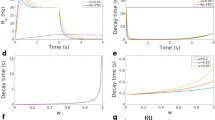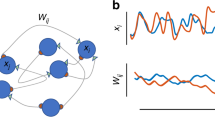Abstract
According to a popular hypothesis, short-term memories are stored as persistent neural activity maintained by synaptic feedback loops. This hypothesis has been formulated mathematically in a number of recurrent network models. Here we study an abstraction of these models, a single neuron with a synapse onto itself, or autapse. This abstraction cannot simulate the way in which persistent activity patterns are distributed over neural populations in the brain. However, with proper tuning of parameters, it does reproduce the continuously graded, or analog, nature of many examples of persistent activity. The conditions for tuning are derived for the dynamics of a conductance-based model neuron with a slow excitatory autapse. The derivation uses the method of averaging to approximate the spiking model with a nonspiking, reduced model. Short-term analog memory storage is possible if the reduced model is approximately linear and if its feedforward bias and autapse strength are precisely tuned.
Similar content being viewed by others
References
Abeles M (1991) Corticonics: Neural Circuits of the Cerebral Cortex. Cambridge University, Cambridge.
Amit DJ (1995) The Hebbian paradigm reintegrated: Local reverberations as internal representations. Behav. Brain Sci. 18:617-626.
Amit DJ, Brunel N, Tsodyks MV (1994) Correlations of cortical Hebbian reverberations: Theory versus experiment. J. Neurosci. 14:6435-6445.
Arnold DB, Robinson DA (1992) A neural network model of the vestibulo-ocular reflex using a local synaptic learning rule. Phil. Trans. R. Soc. Lond. B337:327-330.
Arnold DB, Robinson DA (1997) The oculomotor integrator: Testing of a neural network model. Exp. Brain Res. 113:57-74.
Bekkers JM, Stevens CF (1991) Excitatory and inhibitory autaptic currents in isolated hippocampal neurons maintained in cell culture. Proc. Natl. Acad. Sci. USA 88(17):7834-7838.
Camperi M, Wang XJ (1998) A model of visuospatial working memory in prefrontal cortex: Recurrent network and cellular bistability [in process citation]. J. Comput. Neurosci. 5(4):383-405.
Cannon SC, Robinson DA, Shamma S (1983) A proposed neural network for the integrator of the oculomotor system. Biol. Cybern. 49:127-136.
Ermentrout B (1994) Reduction of conductance-based models with slow synapses to neural nets. Neural Comput. 6:679-695.
Ermentrout B (1998a) Linearization of f-i curves by adaptation. Neural Comput. 10:1721-1729.
Ermentrout B (1998b) Neural networks as spatio-temporal pattern-forming systems. Rep. Prog. Phys. 61:353-430.
Fluster JM (1995) Memory in the Cerebral Cortex. MIT Press, Cambridge, MA.
Georgopoulos AP, Taira M, Lukashin A (1993) Cognitive neurophysiology of the motor cortex. Science 260:47-52.
Griniasty M, Tsodyks MV, Amit DJ (1993) Conversion of temporal correlations between stimuli to spatial correlations between attractors. Neural Comput. 5:1-17.
Hebb DO (1949) Organizational Behavior. Wiley, New York.
Herrmann M, Hertz JA, Prugel-Bennett A (1995) Analysis of synfire chains. Network 6:403-414.
Hertz J, Prugel-Bennett A (1996) Learning short synfire chains by self-organization. Network 7:357-363.
Hopfield JJ (1982) Neural networks and physical systems with emergent collective computational abilities. Proc. Natl. Acad. Sci. USA 79:2554-2558.
Kamath BY, Keller EL (1976) A neurological integrator for the oculomotor control system. Math. Biosci. 30:341-352.
Lorente de No R (1933) Vestibulo-ocular reflex arc. Arch. Neurol. Psych. 30:245-291.
Lubke J, Markram H, Frotscher M, Sakmann B (1996) Frequency and dendritic distribution of autapses established by layer 5 pyramidal neurons in the developing rat neocortex: Comparison with synaptic innervation of adjacent neurons of the same class. J. Neurosci. 16(10):3209-3218.
Maass W, Natschlager T (1997) Networks of spiking neurons can emulate arbitrary Hopfield nets in temporal coding. Network 8:355-371.
Muller RU, Ranck Jr JB, Taube JS (1996) Head direction cells: Properties and functional significance. Curr. Opin. Neurobiol. 6:196-206.
Nakahara H, Doya K (1998) Near-saddle-node bifurcation behavior as dynamics in working memory for goal-directed behavior. Neural Comput. 10(1):113-132.
Prut Y, Fetz EE (1999) Primate spinal interneurons show premovement instructed delay activity. Nature 401(6753):590-594.
Rinzel J, Frankel P (1992) Activity patterns of a slow synapse network predicted by explicitly averaging spike dynamics. Neural Comput. 4:534-545.
Romo R, Brody CD, Hernandez A, Lemus L (1999) Neuronal correlates of parametric working memory in the prefrontal cortex. Nature 399(6735):470-473.
Sanders JA, Verhulst F (1985) Averaging Methods in Nonlinear Dynamical Systems. Applied mathematical sciences. Springer-Verlag, New York.
Segal MM (1991) Epileptiform activity in microcultures containing one excitatory hippocampul neuron. J. Neurophysiol. 65(4):761-770.
Segal MM (1994) Endogenous bursts underlie seizurelike activity in solitary excitatory hippocampal neurons in microcultures. J. Neurophysiol. 72(4):1874-1884.
Seung HS (1996) How the brain keeps the eyes still. Proc. Natl. Acad. Sci. USA 93:13339-13344.
Seung HS (1997) Learning to integrate without visual feedback. Soc. Neurosci. Abstr. 23(1):8.
Seung HS (1998) Learning continuous attractors in recurrent networks. Adv. Neural Info. Proc. Sys. 10:654-660.
Seung HS, Lee DD, Reis BY, Tank DW (2000) Stability of the memory of eye position in a recurrent network of conductance-based model neurons. Neuron. 26:259-271.
Shriki O, Sompolinksy H, Hansel D (1999) Rate models for conductance based cortical neural networks. Unpublished.
Tamas G, Buhl EH, Somogyi P (1997) Massive autaptic self-innervation of gabaergic neurons in cat visual cortex. J. Neurosci. 17(16):6352-6364.
Wang XJ (1998) Calcium coding and adaptive temporal computation in cortical pyramidal neurons. J. Neurophysiol. 79:1549-1566.
Wang XJ, Rinzel J (1992) Alternating and synchronous rhythms in reciprocally coupled inhibitory model neurons. Neural Comput. 1992:534-545.
Zhang K (1996) Representation of spatial orientation by the intrinsic dynamics of the head-direction cell ensemble: A theory. J. Neurosci. 16:2112-2126.
Zisper D, Kehoe B, Littlewort G, Fuster J (1993) A spiking network model of short-term active memory. J. Neurosci. 13:3406-3420.
Author information
Authors and Affiliations
Rights and permissions
About this article
Cite this article
Seung, H.S., Lee, D.D., Reis, B.Y. et al. The Autapse: A Simple Illustration of Short-Term Analog Memory Storage by Tuned Synaptic Feedback. J Comput Neurosci 9, 171–185 (2000). https://doi.org/10.1023/A:1008971908649
Issue Date:
DOI: https://doi.org/10.1023/A:1008971908649




